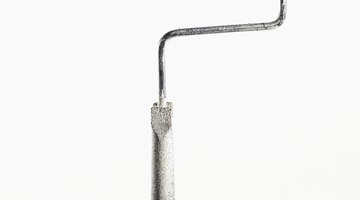How to Stop Air Bubbles in House Paint

Although bubbling paint is usually associated with blisters that form when the paint doesn't adhere to the surface, air bubbles in the paint itself can also result in a bumpy, uneven appearance. It's not possible to prevent air bubbles from getting into the paint, but the proper techniques can stop them from showing up in the finished coat.
Stirring
Stirring paint too vigorously, especially with an electric drill attachment, can draw air into the paint and create an excessive amount of bubbles. This problem tends to happen more often in partial cans of paint, where there is more room to stir. It's impossible to avoid introducing air bubbles into the paint when stirring, but stirring steadily and gently rather than briskly and vigorously will minimize the amount of foam or bubbling.
Application
Just like stirring too quickly, applying the paint too rapidly can draw excess air into the paint. Rollers are more likely to create air bubbles, but paint brushes can also cause a problem. It's not necessary to work at a snail's pace, but don't rush and pull air into the painted surface. Over-rolling or going back over the same spot repeatedly can cause bubbles as the surface the paint creates is broken. It is necessary to overlap strokes, but don't continue to paint over an area once it is adequately covered. Also, using a roller with the wrong nap for the surface, such as a thick nap on a smooth surface, can cause bubbles. Match the nap of the roller to the surface being painted.
Heat
Most quality paints include a self-leveling compound that encourages air bubbles to pop and then smooth out before the paint dries. If either the air or surface temperature is too high, the paint will dry before the bubbles have a chance to be released and the paint leveled. The result will be a finish either with small trapped bubbles or a cratered appearance. Work only when temperatures are within the range recommended by the paint manufacturer, typically below 80 degrees.
Surface Preparation
A slick paint on an unfinished or porous surface may gather air bubbles as it is pushed onto the surface. Gloss and semi-gloss paints are most likely to have this problem. Use a primer that both seals the surface and provides a covering for the paint to grip. Let the primer dry completely before applying the paint.
Thinner and Paint
Adding the wrong type of paint thinner can cause bubbles in the paint when the two don't mix together completely. Make sure the thinner is made for the type of paint you are using; for example, don't mix a product designed for latex paint into oil-based paint. Also, choose a high-quality paint that is self-leveling.
Moisture and Humidity
Painting on a wet surface or during times of high humidity can cause paint to bubble after it is applied. This is different from air bubbles trapped in the paint, and is actually a problem with adhesion. Make sure the surface you are painting is completely dry, especially wood surfaces that can soak up moisture and could take several days to dry. If relative humidity is higher than about 70 percent, wait until the humidity drops before painting so that the paint can cure properly.
References
Photo Credits
- Ryan McVay/Lifesize/Getty Images
- Ryan McVay/Lifesize/Getty Images
More Articles



